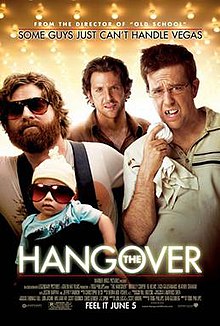Todorov's Theory
One of the narrative theories is 'Todorov', this theory can be applied to a wide range of films :- Equilibrium- All is in order, 'normal' and protagonist is happy
- Disruption- A disruption to the equilibrium by the means of an event/action
- Recognition- There is recognition that a disruption has taken place
- Repair- An attempt to repair the damage caused by the disruption
- New Equilibrium- The problem is solved and we return to a new type of equilibrium

Todorov's theory can be applied the the Hangover:
- One of the main characters are supposed to be getting married so he and his friends go to Las Vegas, this is the equilibrium as everything is in order.
- Group are drugged and wake up the next day not remembering anything, this is the disruption as the equilibrium is out of place.
- The groom is lost so they go on a journey to find him, they find clues along the way that help them remember events from the night before. This is the repair, as they are trying to restore the equilibrium.
- They find their friend and return home in time for the wedding. This means they have restored the equilibruim and and that there is a new type of equilibrium.
Propp's Theory
Another narrative theory is Propp's theory, this is where the roles of characters are established.
- Villain- tries to stop hero reaching goal
- Hero- seeking something
- Donor- gives hero an item of power
- Helper- aids hero
- Princess- something or a person given to hero as a reward
- Her father- rewards hero
- Dispatcher- sends hero on journey
- False hero- takes credit for hero's actions or takes princess
The narrative can be broken down into four spheres:

- 1st sphere: The Introductory Sequence
- 2nd Sphere: The Body of the Story
- 3rd sphere:The Donor Sequence
- 4th sphere:The Hero's return
Propp's theory can be applied to Mean Girls:
- Villain- The Plastics
- Hero- Cady
- Helpers/Dispatchers- Janice and Damien
- The Father- Family and people in school
1st sphere- Cady moving from Africa and starting a new school, this is the introductory sequence as the main character is introduced.
2nd sphere- Cady, to get back at Regina for not letting her go out with Aaron, plans to do horrible things to her with the help of Janice and Damien. This is the body of the story as this is what the whole film is based around.
3rd sphere- The hero, Cady, is tested as Regina flaunts Aaron in front of her. No one likes Regina anymore which means her plan worked. Regina finds out what Cady has been doing so uses the burn book to expose her.
4th sphere- . Cady becomes a plastic and everyone turns against her, however she wins everyone back by apologising at prom, so all is restored. Everyone likes her again so true is recognised.everything then changes; Cady becomes like a normal girl, the plastics break up and new groups have formed. This is the fourth sphere because the hero returns and everything is restored. Levi Strauss
Another narrative theory is Levi Strauss, this is using the binary opposition. Goes by themes rather than events. Examples are:
- Good vs evil
- Man vs woman
- Protagonist vs antagonist
- Young vs old
This theory can be applied to Harry Potter: Harry vs Voldemort, this can be seen as good/evil, young/old.
- In the film we are made to see a contrast between the two characters. As with the idea of opposition between age it makes us see the difference in characters for example Harry is made to look weak against Voldemort. This also highlights the idea of good vs.evil. The film also uses the binary oppositions of dark vs. light, as when we are shown Voldemort especially he is always in darker settings compared to Harry.
The theory can also be applied to the Dark Knight:
- Good vs. Evil, it helps signify the genre of the film, and instantly, within this opening sequence, allows the audience to gain an understanding of what this film is going to be about. The good is the bank workers, who are taking hostage, and the bank manager who attempts to fight back, who initially looks to be a hero, but then is killed and is proven to be a false hero. The evil is the bank robbers, the masked gunman who kill the 'hero' and break into the vault.
No comments:
Post a Comment